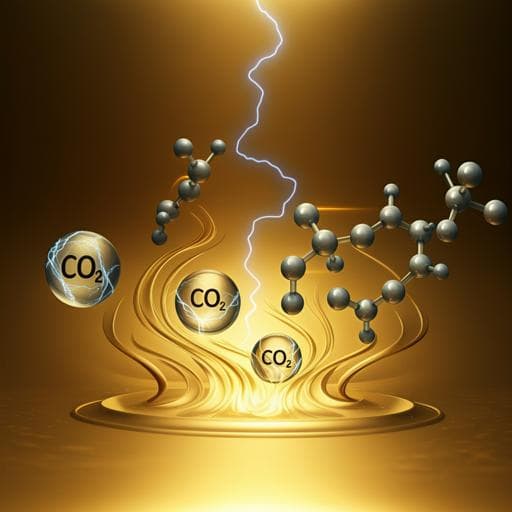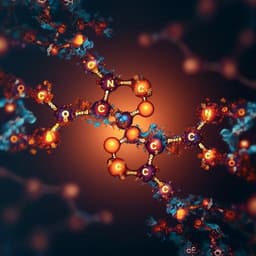
Chemistry
Double layer charging driven carbon dioxide adsorption limits the rate of electrochemical carbon dioxide reduction on Gold
S. Ringe, C. G. Morales-guio, et al.
Discover groundbreaking insights into electrochemical CO₂ reduction, revealing the critical role of CO₂ adsorption and surface charging in the reaction kinetics, conducted by authors including Stefan Ringe and Carlos G. Morales-Guio.
~3 min • Beginner • English
Introduction
The study addresses the long-standing question of the rate-limiting step in electrochemical CO₂ reduction to CO on gold (Au) catalysts. CO₂R is central to carbon-neutral fuel and chemical production when coupled with renewable electricity. Although the accepted pathway involves *CO₂, *COOH, and *CO intermediates, prior reports disagree on whether the limiting step is CO₂ adsorption/electron transfer, proton-coupled electron transfer (PCET) to form *COOH, or conversion of *COOH to *CO. This work combines pH-dependent experiments and multiscale modeling that explicitly includes the electric double layer to determine the limiting step across potentials and to clarify how surface charging and local reaction conditions control kinetics and transport.
Literature Review
Prior studies proposed different limiting steps for CO₂-to-CO on coinage metals: CO₂ adsorption with electron transfer, PCET to form *COOH or a protonated *COOH complex, and electron transfer to *COOH to form *CO. Ab initio-based kinetic models have primarily focused on Ag, sometimes fitting barriers from experiments, and correlating thermodynamics with selectivity. Recent works emphasized mass transport and buffer effects but typically neglected the charged double layer. Other studies highlighted substantial electric-field effects on key intermediates and transition states, as well as cation influences in the Helmholtz layer. The diversity of methods and assumptions has led to conflicting conclusions, motivating a unified multiscale approach that integrates field-dependent energetics, double-layer structure, diffusion/migration, and buffer chemistry.
Methodology
Experiments: CO₂ reduction was conducted on polycrystalline Au foil in a two-compartment cell with ion-exchange membranes (anion-exchange near neutral pH; bipolar at pH 3.0; proton-exchange at pH 1.0). CO₂ (20 sccm) was bubbled through both compartments. Electrolytes included buffered 0.1 M KHCO₃ (pH 6.8) and 0.1 M KH₂PO₄ (pH 3.0), and unbuffered 0.1 M KClO₄ (pH 3.0) and 0.1 M HClO₄ (pH 1.0). The boundary-layer thickness was ~80 μm. Short potentiostatic holds limited pH drift (<0.5 units) in unbuffered systems. Gas products were quantified by online GC. Au and Pt foils were acid-cleaned before use.
Modeling: A multiscale framework coupled (i) ab initio DFT energetics with implicit solvation and a planar countercharge (Environ in Quantum ESPRESSO) to (ii) a mean-field microkinetic model and (iii) a generalized modified Poisson–Nernst–Planck (GMPNP) continuum transport model that explicitly includes the electric double layer (EDL), diffusion, migration, buffer reactions, and finite ion-size effects (modified Poisson–Boltzmann). Reaction plane was set at the outer Helmholtz plane. Reaction energetics were parameterized as functions of electrode potential and surface-charge density via a CHE–Frumkin formulation: integer electron/proton transfer terms plus linear/quadratic field (surface-charge) dependence for intermediates, capturing partial charge transfer and dipole–field interactions. A Robin boundary condition linked applied potential to surface charge via a gap capacitance (C_gap ≈ 20 μC/cm²) and PZC (0.16 V vs SHE). The K⁺ finite size (a_cell ≈ 8.2 Å) modeled crowding at negative potentials; other species were treated as point-like due to their much lower concentrations. The 1D GMPNP equations were solved with fixed bulk concentrations at the boundary layer edge and flux coupling to microkinetics at the reaction plane.
Microkinetics: Considered elementary steps: CO₂(g) adsorption → *CO₂; PCET: *CO₂ → *COOH; PCET: *COOH → *CO → CO(g) desorption. Based on NEB and literature, *CO₂ adsorption and *COOH are well described by thermodynamic stabilization; the *COOH→*CO step was assigned a potential-dependent kinetic barrier (symmetry factor β=0.5; barrier ~0.6 eV at 0 V vs SHE as a representative value) and examined via sensitivity analysis. Mapping turnover frequencies to current employed an active site density derived from grain boundary density on polycrystalline Au: P_act ≈ 9.6 × 10⁻⁵ sites/Ų, consistent with (211)-like undercoordinated sites implicated as active. The CatINT package implemented the self-consistent kinetic–transport solution.
Analysis: Degree of rate control (DRC) was computed to identify rate-limiting states/steps across potentials. Modeled polarization curves and Tafel slopes were compared to new experiments and literature datasets. Potential- and position-dependent species activities (including CO₂ and pH) were analyzed at the reaction plane and at the electroneutrality plane (~10 nm). Cation identity effects were probed experimentally and rationalized via EDL field changes in the model.
Key Findings
- CO partial current density on an SHE scale is invariant with bulk pH (6.8 vs 3.0; no CO at pH 1.0), whereas H₂ currents shift markedly with pH, indicating a non-PCET step limits CO formation under these conditions.
- The multiscale model reproduces the CO polarization curve magnitude, curvature, and Tafel behavior across potentials and aligns with multiple literature datasets.
- Rate-limiting step depends on potential:
• Low overpotentials: *COOH → *CO limits; modeled Tafel slope ≈ 42 mV/dec, consistent with measurements on oxygen-derived Au at very low currents.
• Intermediate overpotentials: CO₂ adsorption limits; modeled Tafel slope ≈ 101 mV/dec, consistent with experimentally observed 120–150 mV/dec when accounting for partial charge transfer and dipole–field interactions.
• High overpotentials: CO₂ mass transport limits; CO₂ activity at the reaction plane decreases, causing polarization curve leveling. Increasing boundary-layer thickness reduces high-overpotential CO currents.
- Field effects: Increasing negative surface charge strongly stabilizes *CO₂ relative to *COOH and *CO, explaining the potential dependence of CO₂ adsorption and the observed Tafel slope without requiring full electron transfer.
- Double layer and local environment: Negative surface charge enriches cations and depletes anions at the reaction plane, increasing local proton activity and stabilizing *COOH by ~120–240 meV relative to *CO₂, making CO₂ adsorption more likely to be rate limiting than *COOH formation. Local pH at the electroneutrality plane increases at high overpotentials due to OH⁻ production and buffer responses; trends with bulk pH agree qualitatively with ATR-SEIRAS.
- Cation effects: Exchanging electrolyte cations significantly affects CO rates (Cs⁺ > K⁺), consistent with stronger Helmholtz-layer field from smaller hydrated cations; HER is largely insensitive, supporting field-driven CO₂ adsorption as rate limiting.
- *CO coverage remains negligible across the potential range, consistent with recent ATR-SEIRAS after accounting for Pt impurities in earlier reports.
- Bicarbonate does not directly supply reactive CO₂ at steady state; reactive CO₂ arrives by diffusion from the boundary layer. Normalizing by local CO₂ concentration collapses bicarbonate dependence, consistent with transport-mediated, not buffer-mediated, supply.
Discussion
The pH-invariant CO currents unequivocally point to a non-PCET rate-limiting step on an absolute potential scale, distinguishing CO₂ reduction from HER behavior in the same system. By explicitly incorporating double-layer charging and field effects into ab initio energetics and transport, the model reconciles seemingly conflicting mechanistic interpretations: at low overpotentials, the kinetically gated *COOH→*CO step dominates, while at practical overpotentials the process is controlled by field-driven CO₂ adsorption until CO₂ transport becomes limiting. The Tafel slope emerges naturally from the potential dependence of surface charge and the resulting stabilization of the dipolar *CO₂ intermediate, rather than from classical full electron-transfer assumptions. The EDL also reshapes the local reaction environment, enhancing proton activity and shifting the relative stability of intermediates, which impacts which step becomes rate limiting. Strong cation dependencies in CO activity, but not HER, further corroborate that interfacial field modulation governs the key kinetic step in CO formation on Au. Overall, integrating EDL physics into kinetics and transport is essential for accurate mechanistic interpretation and rate prediction in CO₂R.
Conclusion
This work resolves the rate-limiting-step controversy for CO₂-to-CO on gold by combining targeted pH-dependent experiments with a multiscale model that integrates field-dependent DFT energetics, microkinetics, and explicit double-layer-aware transport. The main contributions are: (i) experimental demonstration that CO formation rates are pH-invariant on an SHE scale, implicating CO₂ adsorption as rate limiting over a broad potential range; (ii) a mechanistic map showing a transition from *COOH→*CO limitation at low overpotentials, to CO₂ adsorption at intermediate potentials, to CO₂ mass transport at high overpotentials; (iii) identification of the Tafel slope origin in the electrostatic stabilization of the dipolar *CO₂ intermediate by the interfacial field; and (iv) clarification that reactive CO₂ is supplied by diffusion rather than bicarbonate buffering under steady-state conditions. Future directions include tuning interfacial charging to accelerate field-driven steps (e.g., modifying the potential of zero charge via co-adsorbates or impurities, altering Helmholtz gap capacitance, engineering cation identity/size/charge, or applying external fields via field-effect devices), and exploiting charge-controlled local pH to steer selectivity in pH-sensitive electrocatalytic pathways.
Limitations
- The microkinetic model excludes HER; while justified by low HER rates at pH 6.8 except in transport-limited regimes, HER could influence local pH at high currents.
- The active site density is inferred from grain-boundary correlations and assumed constant; uncertainties in true active-site population affect absolute current predictions and kinetic–transport coupling.
- A specific undercoordinated Au facet (211) is used as a representative active site; real polycrystalline surfaces present a distribution of sites.
- The *COOH→*CO barrier is treated as a parameter (β=0.5, barrier ~0.6 eV at 0 V) guided by NEB and literature; exact barrier values on Au remain uncertain.
- Finite ion-size effects are included only for K⁺ (dominant in the EDL); other species are treated as point-like, which may miss subtle crowding effects at extreme conditions.
- The model assumes a constant gap/double-layer capacitance over the potential range; capacitance variations or specific adsorption could alter σ(U).
- Hydrodynamics are simplified to a 1D, stationary boundary layer (≈80 μm); deviations in experimental flow/stirring may contribute to discrepancies (e.g., pH overestimation at high overpotentials).
- Kinetic isotope effect interpretation can be confounded by transport-related isotope effects; thus KIE alone is not definitive for mechanistic assignment.
- No CO detected at pH 1.0 in experiments may reflect overwhelming HER and transport constraints; mechanistic conclusions are drawn from pH 3.0–6.8 where CO is observed.
Related Publications
Explore these studies to deepen your understanding of the subject.







